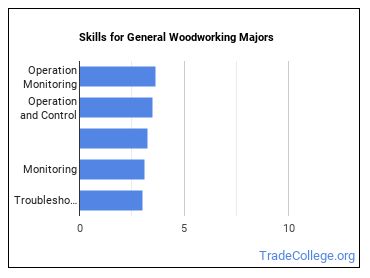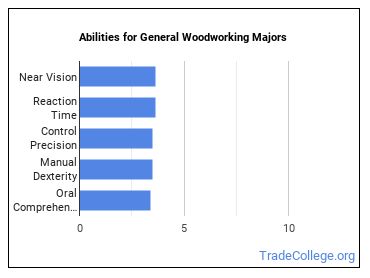Find Trade Colleges
Woodworking
Types of Degrees Woodworking Majors Are Getting
The following table lists how many general woodworking graduations there were in 2021-2022 for each degree level.
| Education Level | Number of Grads |
|---|---|
| Basic Certificate | 24 |
| Undergraduate Certificate | 11 |
| Associate Degree | 3 |
What Woodworking Majors Need to Know
People with careers related to woodworking were asked what knowledge areas, skills, and abilities were important for their jobs. They weighted these areas on a scale of 1 to 5 with 5 being the highest.
Knowledge Areas for Woodworking Majors
Woodworking majors often go into careers in which the following knowledge areas are important:

- Mechanical - Knowledge of machines and tools, including their designs, uses, repair, and maintenance.
- Production and Processing - Knowledge of raw materials, production processes, quality control, costs, and other techniques for maximizing the effective manufacture and distribution of goods.
- Mathematics - Knowledge of arithmetic, algebra, geometry, calculus, statistics, and their applications.
- Public Safety and Security - Knowledge of relevant equipment, policies, procedures, and strategies to promote effective local, state, or national security operations for the protection of people, data, property, and institutions.
- Building and Construction - Knowledge of materials, methods, and the tools involved in the construction or repair of houses, buildings, or other structures such as highways and roads.
Skills for Woodworking Majors
When studying woodworking, you’ll learn many skills that will help you be successful in a wide range of jobs - even those that do not require a degree in the field. The following is a list of some of the most common skills needed for careers associated with this major:

- Operation Monitoring - Watching gauges, dials, or other indicators to make sure a machine is working properly.
- Operation and Control - Controlling operations of equipment or systems.
- Quality Control Analysis - Conducting tests and inspections of products, services, or processes to evaluate quality or performance.
- Monitoring - Monitoring/Assessing performance of yourself, other individuals, or organizations to make improvements or take corrective action.
- Troubleshooting - Determining causes of operating errors and deciding what to do about it.
Abilities for Woodworking Majors
As a woodworking major, you will find yourself needing the following abilities:

- Near Vision - The ability to see details at close range (within a few feet of the observer).
- Reaction Time - The ability to quickly respond (with the hand, finger, or foot) to a signal (sound, light, picture) when it appears.
- Control Precision - The ability to quickly and repeatedly adjust the controls of a machine or a vehicle to exact positions.
- Manual Dexterity - The ability to quickly move your hand, your hand together with your arm, or your two hands to grasp, manipulate, or assemble objects.
- Oral Comprehension - The ability to listen to and understand information and ideas presented through spoken words and sentences.
What Can You Do With a Woodworking Major?
Below is a list of occupations associated with woodworking:
| Job Title | Job Growth Rate | Median Salary |
|---|---|---|
| Woodworkers | 3.3% | $31,170 |
| Woodworking Machine Setters, Operators, and Tenders, Except Sawing | 0.5% | $29,730 |
Who Is Getting an Associate’s Degree in Woodworking?
Racial-Ethnic Diversity
At the countrywide level, the racial-ethnic distribution of woodworking majors is as follows:

| Race/Ethnicity | Number of Grads |
|---|---|
| Asian | 0 |
| Black or African American | 0 |
| Hispanic or Latino | 0 |
| White | 2 |
| International Students | 0 |
| Other Races/Ethnicities | 1 |
How Much Do Woodworking Majors Make?
Salaries According to BLS
Woodworking majors often go into careers where salaries can range from $31,110 to $34,530 (25th to 75th percentile). This range includes all degree levels, so the salary for a person with just a bachelor’s degree may be a little less and the one for a person with an advanced degree may be a little more.
To put that into context, according to BLS data from the first quarter of 2020, the typical high school graduate makes between $30,000 and $57,900 a year (25th through 75th percentile). The average person with a bachelor’s degree (any field) makes between $45,600 and $99,000. Advanced degree holders make the most with salaries between $55,600 and $125,400.
Amount of Education Required for Careers Related to Woodworking
Some degrees associated with woodworking may require an advanced degree, while others may not even require a bachelor’s in the field. Whatever the case may be, pursuing more education usually means that more career options will be available to you.
Find out what the typical degree level is for woodworking careers below.

| Education Level | Percentage of Workers |
|---|---|
| Less than a High School Diploma | 19.7% |
| High School Diploma - or the equivalent (for example, GED) | 69.7% |
| Post-Secondary Certificate - awarded for training completed after high school (for example, in agriculture or natural resources, computer services, personal or culinary services, engineering technologies, healthcare, construction trades, mechanic and repair technologies, or precision production) | 4.3% |
| Bachelor’s Degree | 1.6% |
Online Woodworking Programs
The following table lists the number of programs by degree level, along with how many schools offered online courses in the field.
| Degree Level | Colleges Offering Programs | Colleges Offering Online Classes |
|---|---|---|
| Certificate (Less Than 1 Year) | 0 | 0 |
| Certificate (1-2 years) | 7 | 0 |
| Certificate (2-4 Years) | 0 | 0 |
| Associate’s Degree | 4 | 0 |
| Bachelor’s Degree | 0 | 0 |
| Post-Baccalaureate | 0 | 0 |
| Master’s Degree | 0 | 0 |
| Post-Master’s | 0 | 0 |
| Doctor’s Degree (Research) | 0 | 0 |
| Doctor’s Degree (Professional Practice) | 0 | 0 |
| Doctor’s Degree (Other) | 0 | 0 |
Is a Degree in Woodworking Worth It?
The median salary for a woodworking grad is $31,110 per year. This is based on the weighted average of the most common careers associated with the major.

Explore Major by State
Alabama
California
District of Columbia
Idaho
Kansas
Maryland
Mississippi
Nevada
New York
Oklahoma
South Carolina
Utah
West Virginia
Alaska
Colorado
Florida
Illinois
Kentucky
Massachusetts
Missouri
New Hampshire
North Carolina
Oregon
South Dakota
Vermont
Wisconsin
Trades Related to Woodworking
You may also be interested in one of the following majors related to woodworking.
| Major | Number of Grads |
|---|---|
| Cabinetmaking & Millwork | 340 |
| Furniture Design & Manufacturing | 42 |
| Other Woodworking | 15 |
| Wooden Boatbuilding Technology | 0 |
References
*The racial-ethnic minorities count is calculated by taking the total number of students and subtracting white students, international students, and students whose race/ethnicity was unknown. This number is then divided by the total number of students at the school to obtain the racial-ethnic minorities percentage.
- College Factual
- College Scorecard
- National Center for Education Statistics
- O*NET Online
- U.S. Bureau of Labor Statistics
- Usual Weekly Earnings of Wage and Salary Workers First Quarter 2020
More about our data sources and methodologies.
